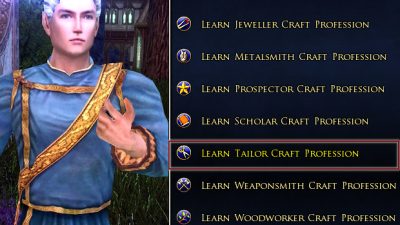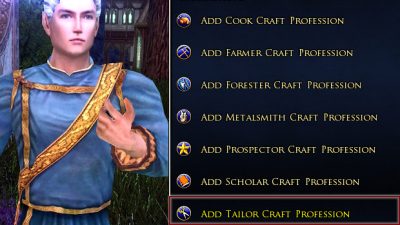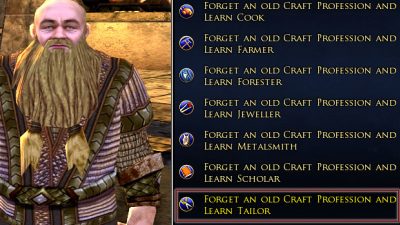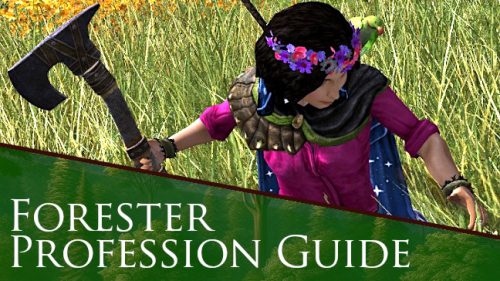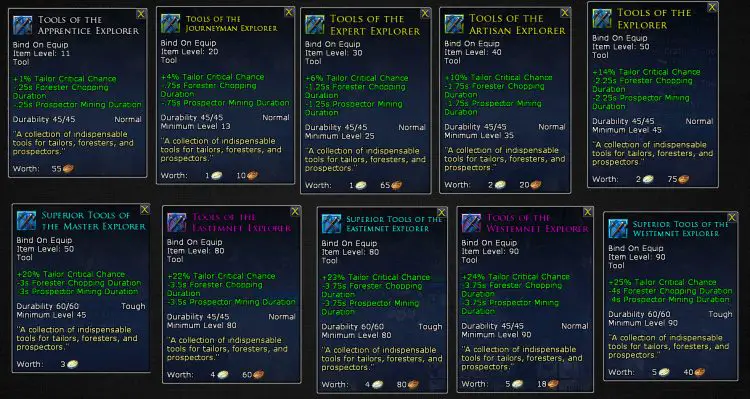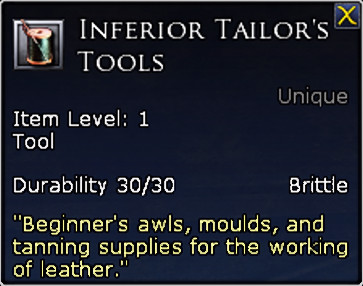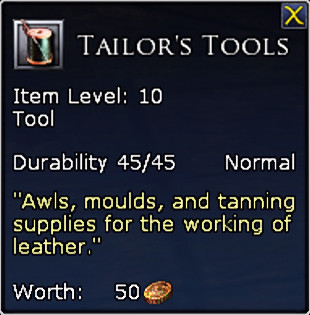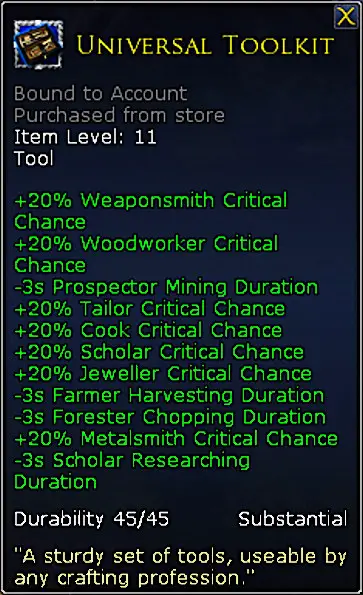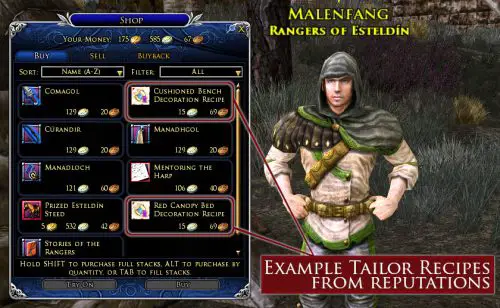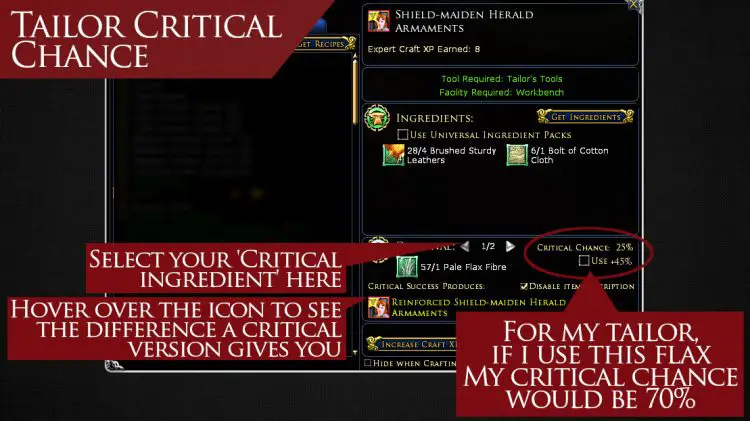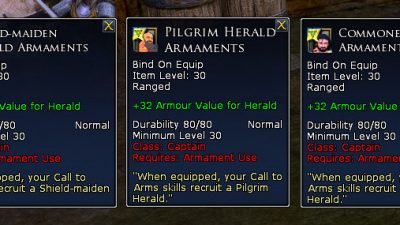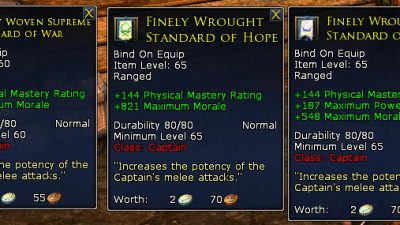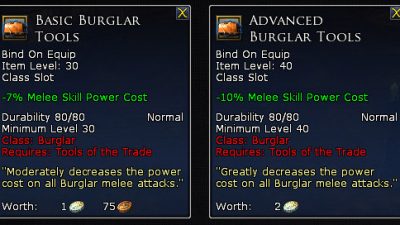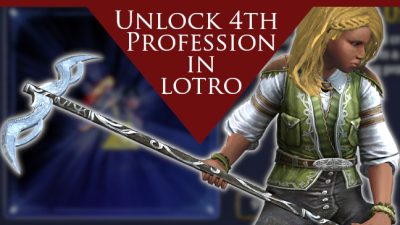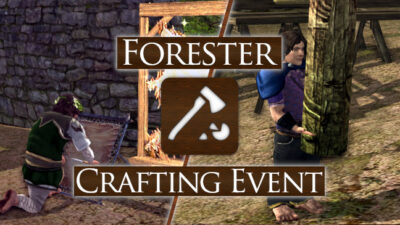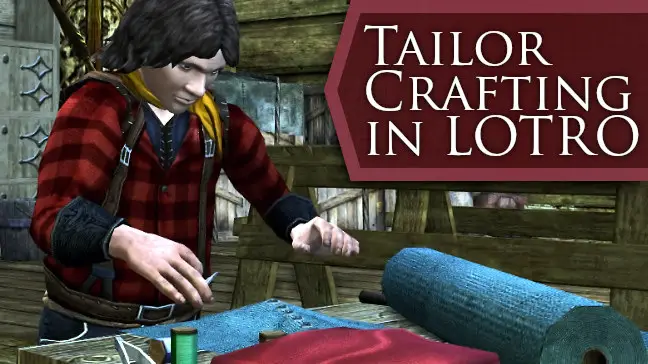
Post Sections ⇅
- What is the Tailor Profession?
- How to Unlock Tailor Crafting in LOTRO
- Which Gathering Profession Should You Use for Tailors?
- What Materials Do Tailors Need?
- Tailor Crafting Tools
- Where to get Tailor Crafting Recipes
- How to Do Tailor Crafting in LOTRO
- What is “Critical Chance”?
- How to get Proficient as a Tailor
- Unusual Things Tailors Can Make
- Tailors Guild FAQs
- Tips to be a better Tailor in LOTRO
The LOTRO Tailor crafting profession is one of the choices available to you when you pick up crafting. You can cook food, make concoctions, hammer metal armour or weapons, work with wood and learn from ancient texts. As a Tailor, you can make Light and Medium Armour, including cloaks. However, there are some other aspects of your LOTRO experience it can enhance too.
So, let’s take a look and see if being a Tailor will suit you in your adventures in The Lord of the Rings Online.
What is the Tailor Profession?
Tailoring in LOTRO encompasses both fabric- and leatherworking, with the majority of recipes being for light and medium armour.
Unlike some other games, you do not need to harvest plants for the weaving side of it. However, there are some botanical items that can help you, as we will see.
How to Unlock Tailor Crafting in LOTRO
So you’ve decided you want to make Light or Medium armour and cloaks. How do you get Tailor unlocked?
1. Find a Master/Mistress of Apprentices

Speak to a Master or Mistress of Apprentices in order to start a crafting profession. They are also the ones who can help you drop a profession to take up a new one.
2. Select the Tailor Profession
From the options presented, select Tailor. You will see one of three types of wording:
- Learn: if you have no crafting abilities right now, then you will simply “Learn” one.
- Add: You have at least one other profession, but not the maximum number. You can “Add” to your professions and begin sewing and stitching.
- Forget a Crafting Profession and Learn: You have the maximum number of professions. In this case, you will have to totally forget one to pick up tailor crafting. Do this carefully, as you will lose all progress on the dropped profession, even if you pick it back up later.
3. Do the Tutorial
All the gathering and crafting professions have a tutorial. While it is optional, if you’re new to LOTRO it helps you become familiar with the tools and crafting facilities you need.
Plus, you generally get a free item out of it as well as your starter tools.
The Different Wording for Learning Tailoring
Which Gathering Profession Should You Use for Tailors?
For me, this is a simple choice:
Given there are only three traditional gathering professions in LOTRO, the one most suited to the task is the Forester profession.
It is ideally suited to Tailor because:
- It processes collected hides into leathers.
- You can find other tailor-related items while chopping wood in the wilds.
- Some crafted Tailor tools cover both Forester and in the one item.
A Bit More Detail
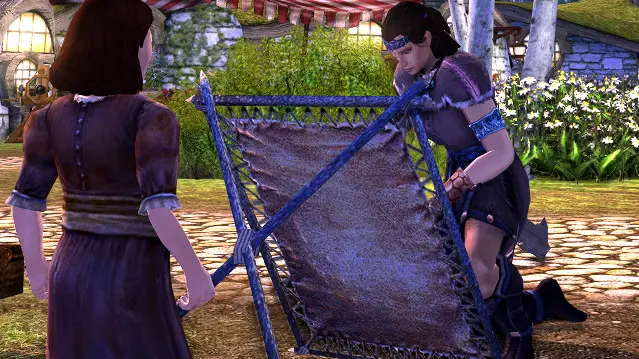
- The physical preparation of materials for a Tailor relates to treating animals hides. Hides are turned into leathers by Foresters. The same applies when you need to create extra-strong leathers for specialist recipes. (See: Waxed and Glazed Leathers)
- Some homestead decorations may require wood (Red Canopy Bed
 ). As a bonus, Forester sometimes has its own decoration recipes (e.g. Log-Holder
). As a bonus, Forester sometimes has its own decoration recipes (e.g. Log-Holder ).
). - Both Foresters and Tailors share the same crafting facility, the Workbench. This means no to-ing and fro-ing across whichever craft hall you’re in.
- Prospector (Mining) won’t give you the critical chance items required by the Tailoring crafting profession.
But I already have a Forester, or Five!
Did you over-indulge in the LOTRO Forester event, per chance?
Do you have a slot or two still to spare? Then look at what else you could make for yourself. Here are a few starting points:
- If you’re a Hunter, then become a Woodworker. That way you can craft your bow and potentially both of your melée weapons.
- Warden Spears and Javelins are created with wood, as are Warden Carvings.
- Other Light Armour classes will find Woodworker complements Tailoring: for example, by making Lore-master staves and Minstrel instruments.
- For all Classes, becoming a Jeweller is a benefit. This is because you can make seven, and sometimes eight, pieces of gear with it. Though, you would need to take up Prospecting, either on that character or another.
- Take a look at Scholar crafting. With it, you can create scrolls that improve your crafting and combat abilities. If you’re a Hunter, then Scholars make fire- and light-oils for your arrows. Scholar is an all-encompassing gathering and crafting profession.
- Take up Farming or Cooking to help create foods that help you in battle.

What Materials Do Tailors Need?
Here is a summary list of the types of ingredients you may need as a Tailor in LOTRO:
 Leathers, made from animal hides (See other example Hides).
Leathers, made from animal hides (See other example Hides). Wax, when making stronger leather (See Glazed Leathers)
Wax, when making stronger leather (See Glazed Leathers) Bolts of Cloth and/or Spools of Thread from suppliers.
Bolts of Cloth and/or Spools of Thread from suppliers.- Optional: an ingredient to increase your critical chance.
- Ingredients for Special Recipes:
 Shards (There are various types of these).
Shards (There are various types of these). Other Rare Components.
Other Rare Components.
- Guild Items (More on the Tailors Guild here)
Obviously, not all recipes will need all of these! But as you get deeper into the game or unlock rarer recipes, needing four or even five ingredients is not uncommon.
Example Hides
Each tier has its own “grade” of hide and leather. The creatures in some regions may drop different grades depending on the level of the animal they drop from.
Though the idea of a dead defeated creature automatically dropping its skin is kinda gross if you think about it. Actually, don’t think about it.
| Light Hide (Apprentice) | |
| Medium Hide (Journeyman) | |
| Sturdy Hide (Expert) |
Wax and Glazed Leathers
Wax is used to reinforce leathers. This is a process that Foresters do, and is often referred to as Glazing.
The Glazing Process
The process of glazing is usually along these lines:
- Create Brushed Leather.
- Take 2 × Brushed Leather and 1 × Wax to make a Glazed Leather.
- Take 2 × Glazed Leather and 1 × Wax to make a Finished Leather.
Where do I Get Lumps of Wax?
You have to purchase these from a Supplier NPC. For some reason, LOTRO never put Tailor/Forester ingredients on the Apprentice and Expert Tailor NPCs.
There are varying grades of Wax, but for the first few tiers, good old
Lumps of Wax for a few
copper coins are all you need.
Only certain recipes will require “finished” leathers, but they usually relate to the strongest grade of items for that tier.
Many Tailor recipes from the Expert tier onwards will require glazed leathers. Sometimes they will need extra reinforcement, hence having the “finished” level. Not “double-glazing” like I originally typed, as that’s for windows.
Materials from Suppliers
As we’ve already seen, wax comes from Suppliers. But that’s not the only ingredient you acquire this way – and you almost always need to purchase components. Why?
The Tailor crafting profession’s main focus is clothing – a word with “cloth” in it. But, unlike other MMOs, you do not harvest fabric-making plants in LOTRO. We cannot be spinners or weaver – in LOTRO those titles are reserved for spiders!
The closest plant is uncovering flax, which you implausibly find inside fallen branches.
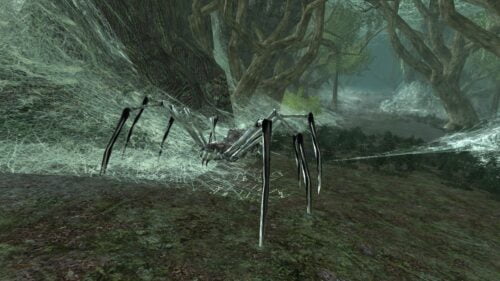
Not the Tailor’s Guild Location
So, you provide the animal skins (converted to leathers), but the actual cloth and thread comes from vendors. Just see it as supporting local businesses.
You can find the full list of suppliers on the Wiki
. And you can find their list of wares at https://lotro-wiki.com/wiki/NPC_Supplier
.
Tired of Carrying so Much in Your Bags?
I went through all of LOTRO’s storage options to find the best value for money.
Here’s what I found – I hope it helps you manage all those resources!
Tailor Crafting Tools
The more I write about LOTRO crafting and gathering, the more I see overlaps. I really try not to repeat myself in these instances, but it can be difficult.
When it comes to Tailor crafting tools, there is cross-over with some of the Forester tools. But here are the different tools/toolkits you can currently use as a Tailor:
 Inferior Tailor’s Tools: Free from the Tailor Tutorial
Inferior Tailor’s Tools: Free from the Tailor Tutorial Tailor’s Tools: 2×
Tailor’s Tools: 2× from a Supplier or an Novice/Expert Tailor NPC
from a Supplier or an Novice/Expert Tailor NPC- Crafted: Metalsmiths can craft multi-tools that cover some crafting and gathering professions in one item. Tailoring features in a few types:
- Tools of the … Explorer
- Tools of the … Yeoman
- Tools of the … Armourer
- LOTRO Store:
- Universal Toolkit
 :
:  ×150 and may also appear in Valar packages, depending which one you have used. The Wiki page I’ve linked to shows a few other sources.
×150 and may also appear in Valar packages, depending which one you have used. The Wiki page I’ve linked to shows a few other sources. - Enduring Universal Toolkit
 :
:  ×450
×450 - Certain expansion purchases may contain universal tools
- Universal Toolkit
Also, apologies for the repetition of words here. Unfortunately, when the name says what the item is, repetition is inevitable.
The crafted multitools are named from the old crafting professions. At the date of writing (February 2024), these have not been renamed, nor split into their component professions.
However, they are still far more durable than the NPC-purchased one. And it means you only need to carry one item to cover two or three professions, depending on which ones you have unlocked.
What Does Durability Mean?
Durability is a grade that shows how much an item can be used before it needs to be repaired.
In LOTRO, all gear, including weapons and tools have a durability rating. When items are used – like combat gear in fighting, or crafting tools in…well, crafting – the durability reduces. If that reaches zero, you will be unable to use your tool until you have it repaired by an NPC.
How Durability is Measured
There are two “measures”:
- Number: How many health-points your tool has left.
- Text: An indicator as to how quickly those points are used up.
Comparing Tools
So here we see:
- The Inferior tool only has 30 Durability and is Brittle. So, it’ll wear out quite quickly.
- Both the “regular” Tailor’s Tools and the Universal Toolkit have 45 Durability. But the Universal one is marked as Substantial rather than Normal. This means it takes longer to use up the 45 points.
VIP? Don’t Fret on Durability.
If you pick up the Town Services from Wenda Cranesbill, you also get your Subscriber’s Jug. This means none of your gear uses durability (so long as you remember to use your Jug!).
As this includes crafting/gathering tools, you need only think about the other stats your tool provides.
If you’re a VIP, the only bonus of the Enduring Universal Toolkit is a reduction of gathering time by an additional 1½ seconds.
Where to get Tailor Crafting Recipes
Great, so we have you trained and equipped. So, how do you make stuff?
Regardless of your LOTRO crafting profession, what you can create is dependent on crafting recipes. But how do you fill your recipe book?
How to Get Tailor Recipes & Scroll Cases
Here is a summary list of places or sources. However, I have explained these in more detail on my main crafting guide under Where to Get Crafting Recipes.
- Auto-Unlocks
When you first unlock a tier of tailor crafting, that tier will have a few recipes in it to start off with. At higher tiers that number dwindles. - Defeated Humanoids
Humans, Orcs, Goblins, Uruks and even Trolls (I think), can drop scroll cases. They won’t always drop Tailor Crafting Scrolls, but they can. - Lockboxes
On-landscape lockboxes (or crates, or similar description) can sometimes contain scroll cases. - Reputation Vendors
Depending on your Reputation, some factions may offer crafting recipes. My example image here is from the Rangers of Esteldin. - Skirmish Camps
Not simply for training your Skirmish Soldier, you can spend your Marks for Scroll Cases too.
Marks for Scroll Cases too. - Repeatable Quests
In a small number of regions, you can be awarded Scroll Cases for repeatable quests. See my main crafting guide for more information. - The Tailors Guild
I’ll cover this in more detail shortly, but the Tailors Guild in Esteldin is a great source of recipes that help you create really strong armour.
What’s a Scroll Case?
It’s a container that picks a random recipe from the tier and profession indicated in the description.
North Downs Recipe Example
You won’t get access to all recipes straight away. But as you rise up in a faction, they will open up to you.
In this case – you had better start on those North Downs deeds!
Multi-Recipes
Not all recipes are simply one recipe. Let me explain!
Tailors make armour that suits light and medium classes, yes? That covers a lot of classes in LOTRO. From Hunter to Rune-keeper and Warden to Lore-Master. But they need different combat stats and when you’re gearing up in LOTRO, it’s the numbers that determine how good you are at fighting the Enemy.
“Multi-Recipes” allow you to learn to make an item, but with a different emphasis on those combat statistics. You may also find that some multi-recipes give different appearances depending on the recipe too.
Example from In-Game
Let me show this through the Tailor’s Guild recipe Exquisite Outrider’s Armour![]() , one of the first ones you can unlock there.
, one of the first ones you can unlock there.
Armour
Appearance
Stats
- +19 Agility
- +9 Vitality
- +70 Physical Mastery
Appearance
Stats
- +19 Agility
- +9 Vitality
- +82 Physical Mitigation
Appearance
Stats
- +18 Agility
- +7 Vitality
- +55 Physical Mastery
- +46 Critical Rating
So, multi-recipes are great for customising your gearing, but also for making new cosmetics. I have chosen a guild recipe here, but the L25 “Outrider’s Amour![]() ” is a non-guild recipe and gives similar appearance differences.
” is a non-guild recipe and gives similar appearance differences.
How to Do Tailor Crafting in LOTRO
As already mentioned, Tailoring requires you to turn hides into leathers. So, to make this easier, I have assumed here that you have the Forester Gathering profession.
If Tailor and Forester are Different Characters
If you don’t have this on the same character as tailoring then this is how to approach it:
- Ensure your hides are sent to the “processing” Forester character.
- Process them.
- Send back the leathers either through the mail, or via some storage method.
The Crafting Process
Here’s how to go about making your new armour or cosmetic outfit pieces.
1. Get your Materials

For tailors that means “go and hunt wild creatures for their skins”. But you can also use Forestry, and cut some wood to try and find Flax Fibres.
If you’ve just started crafting, then here are a couple of links to help you find your Light and Medium hides.
You may find some available on the Auction House, but if you’re new-ish to LOTRO, then you may find yourself priced out. Joining a Kin may help you get established in crafting. Then, when another newer player joins you, you can help them out, too.
2. Find a Workbench
The Workbench is both the Forester and the Tailor’s crafting facility. A good, unexciting-looking table. A table you’ll ignore, because you have a hide stretcher.
A table you’ll ignore because you have a magic “pocket table” that you use when doing your sewing.
But you have to be near the Workbench to create your items. So there’s that.
Pro-tip: If your Forester and Tailor are on different characters, save yourself some time by keeping both are near a workbench for your crafting session. No matter how much you plan, suddenly needing more leathers or extra glazing happens!
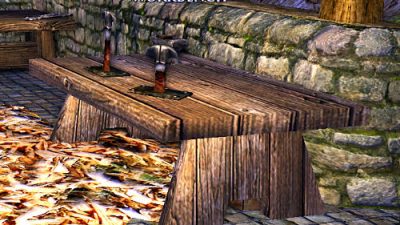
3. Choose Your Crafting Recipe
…and make sure you have all the materials! Some may need purchasing from an NPC vendor called a “Supplier”.
Once you’ve chosen you’re recipe, you will need to figure out how many of each ingredient your recipe needs. This is especially important for hides.
4. Process Hides
For Apprentice and Journeyman Tailor, you only have to think about ![]() brushed leathers. But from Expert onwards, you may need to consider glazed leathers.
brushed leathers. But from Expert onwards, you may need to consider glazed leathers.
And you have to hope you collected enough hides for the task!
How to Check Hides Required
You need to work backwards from the number of leathers required, to find out how many hides you need to harvest.
Noble Cloak Example
Required Materials:
- 4 × Glazed Magnificent Leathers: Requires 8 × Brushed Magnificent Leathers and 2 × Lumps of Wax
- 2 × Finished Magnificent Leathers: Requires: 4 × Glazed Magnificent Leathers and 2 × Lumps of Wax
So to make one measly cloak, you need to make 8 × Glazed Leathers, which requires 16 × Brushed Leathers – i.e. 32 skins. That’s a lot of dead animals to make one cloak!
32 skins → 16 Brushed → 8 Glazed <keep 4> → 2 Finished <no materials left>
5. Critical Chance?
Now you have your hides and the crafting character has them, it’s time to make your item. Almost.
Now, check whether you have “critical chance” unlocked for your tier. This is available once the bronze Crafting XP bar has filled up.
If you do, then make sure your ![]() Flax Fibres (the right grade for the right tier), or
Flax Fibres (the right grade for the right tier), or ![]() Universal Optional Ingredients are in your bags.
Universal Optional Ingredients are in your bags.
They can also be in carry-alls, if the carry-alls are in your bags.
6. Choose an option if it’s a multi-recipe
Remember that all “stat gear” can be used to make cosmetic outfits too. This is especially true if you have the ![]() Wardrobe unlocked.
Wardrobe unlocked.
If you don’t mind what it looks like (because you have Festival Cosmetic Outfits, or something else far more fashionable on already), then decide which stats you want to improve.
7. Make Your Item
Hit that Make button and finally craft your item, hurrah!
At this point, you probably want to decide if you want it in an outfit, or in your wardrobe. If you’re crafting to improve your stats, you will be equipping this as armour, so you don’t have to decide now. It’s just a thought.
What is “Critical Chance”?
Critical Chance is the probability that you will make a better item than the standard one. You can increase or even guarantee your Critical Chance using certain other ingredients. The crafting panel will tell you what possible critical outcomes are possible for your recipe.
Critical Chance Items for Tailor Crafting
Here are some example items that increate your critical chance:
 Common Flax Fibre (Apprentice)
Common Flax Fibre (Apprentice) Bree Flax Fibre (Journeyman)
Bree Flax Fibre (Journeyman) Universal Optional Crafting Ingredient (this item guarantees a critical/improved version. It is consumed on use, but you can get one free/week by completing weekly quest The Tasks at Hand
Universal Optional Crafting Ingredient (this item guarantees a critical/improved version. It is consumed on use, but you can get one free/week by completing weekly quest The Tasks at Hand ).
).
Flax is a type of plant that, if grown and processed correctly, can be used in the production of linen. It is apparently, one of the oldest textile fibres in our history
.
How to get Proficient as a Tailor
As is true for all crafting tiers, there are 2 levels within each Tailoring tier: Proficiency and Mastery.
- You are Proficient once you’ve earned enough
 crafting XP to fill the bronze-coloured progress bar. This is done through completing that’s tiers recipes in the Tailor tab.
crafting XP to fill the bronze-coloured progress bar. This is done through completing that’s tiers recipes in the Tailor tab. - You reach Mastery, once you fill the gold bar with crafting XP from completing recipes in that tier.
Once you have completed a tier’s Proficiency level, you unlock Critical Chance on recipes in that tier.
Unusual Things Tailors Can Make
While we consider those who do sewing to be predominantly dealing with clothes, that is not the only thing they can do. This is true in our world. We once had a family friend who was a very capable maker and mender of clothes, but their specialism was curtains.
So what other items can Tailors in LOTRO make? Here are a few examples:
Decorations

While there are not that many, Tailors can craft a few decorations. Usually these are rugs and tapestries. But this Rangers of Esteldín bed is an exception to that rule!
Captain Herald Armaments
These items allow Captains to change the kind of companion/pet they have with them. These also include buffs for their herald.
Captain Standards
Captains can stand up a Standard (Banner) in battle. These create an area that benefits allies, or weakens enemies.
Burglar Tools (and Signals)
These are items for sneaky hobbitses, or any other races! Early ones reduce the power cost of Burglar abilities.
Later, Signals![]() have various effects in Fellowships.
have various effects in Fellowships.
Rune-keeper Satchels

Rune-keepers need to keep their engraved lumps of rock somewhere.
But they’re not just for storage. Satchels grant Rune-keepers bonuses to different attack types.
Tailors Guild FAQs
I wanted this guide to tailor crafting to be about the “normal” making of items for newer players. So, I decided to leave a detailed look at crafting guilds until another post. That said, a quick overview here would probably be helpful for you.
What is the Tailors Guild?
It is a special group of NPCs who offer you tailor recipes to make much stronger items than you can normally. It is not a “guild” in the sense of it being a player group. Though, that’s not to say you won’t find Kinships who specialise in crafting!
The Guild is also a reputation faction, where you need to rise through the ranks to unlock better crafting recipes and those in higher tiers.
Do I Have to Join the Tailors Guild?
No, guilds are purely optional. But some cosmetic appearances can only be found within guild recipes. So that alone might entice you!
Where is the Tailors Guild?
You can find it in the Craft-Hall of Esteldín, which is in the North Downs. The Ranger settlement is in the eastern portion of the North Downs.
How Do I Join It?
To join the Tailors Guild you must:
- Be proficient as an Expert Tailor (Tier 3)
- Find a Master of Crafting Guilds somewhere in Middle-Earth and speak with them.
Speak to whichever one you find. When you’re asked “Do you want to join the Tailor’s Guild”, your answer is “Train”.
Follow the Quest
The Master of Crafting Guilds will have an introductory quest for you. You will need to complete this to finalise your membership of the Tailors Guild.
Ignore the fact that, in Caredgam’s case, he talks about you needing to go to Esteldín in the North Downs. Because you’re already there! Apparently all Masters of Crafting Guilds are forced to read the same script. Terms and Conditions apply, while stocks last.
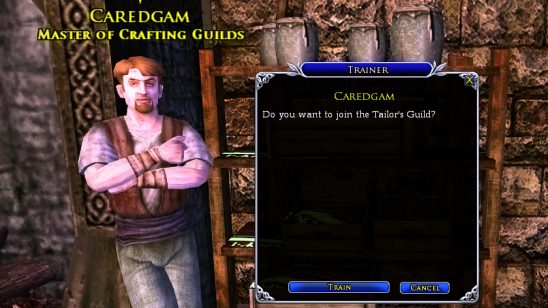
You can find this dude, Caredgam, in the Craft-Hall of Esteldín. That saves you the hassle of finding another one then going to the North Downs.
I’ll follow this up with a proper guild guide soonish. At least now you can explore that avenue from Tier 3 of Tailor crafting.
Tips to be a better Tailor in LOTRO
While you cannot fail to craft an item in LOTRO, there are ways to improve or streamline the process.
- Stockpile hides in your storage or another character’s.
- Consider a Crafting Carry-all. The stacks you can store in those are much higher than in your bags. Though see my guide to storage on the price of Carry-Alls.
- Keep track of the special ingredients and keep them all on the Tailor character. It can be too easy to have ingredients taking up space on multiple characters!
- Take questing breaks to process ingredients even if you don’t need to make anything at that moment. That way, levelling up your tailoring skills won’t feel so much of a grind.
- Keep your eyes peeled for reputation recipes. These can often be strong items, or have unique cosmetic appearances.
- Do your weekly The Tasks at Hand
 quest so you can get a universal optional ingredient. They guarantee a Critical item on making your robes or armour (and anything else in the non-gathering tabs!).
quest so you can get a universal optional ingredient. They guarantee a Critical item on making your robes or armour (and anything else in the non-gathering tabs!). - Be willing to lend a hand to other players. Sometimes you’ll spot someone asking for something to be made. Be community and help out.
- You may find some LOTRO Plugins can help you keep track of your crafting. Take a look on LOTRO Interface here
 for the options.
for the options.
TL;DR Get on with Tailor Crafting for Gear and Cosmetics
Tailors are versatile crafters who can make cloaks, light armour and medium armour. But they can make items that support Captains and Burglars too.
When coupled with the Forester gathering profession, you can create many of your own gear items, or those for other people. So add it to your skills, or at least one of your character’s skills with confidence. You’ve slain so many creatures for coins, you may as well turn their hides into clothes, after all!
Have fun in Middle-Earth!

